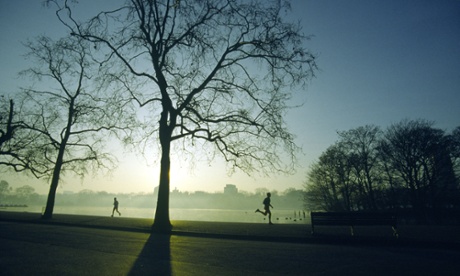
Last week as I lay on my back with leg in the chiropractor’s hands, bent into my chest, she said these words: “I think with your back and your knees, your running days are over.”
I haven’t run for over a year. But, in my heart, I’m still a runner, and always will be. Running was just waiting for me to get back into it. No one was going to tell me my running days were over. I intended to run into old age, maybe even over a cliff one day.
Me and running go back a long way. I started when I was in sixth form, when absolutely nobody else I knew was doing it. Just as sport was no longer part of the school timetable, I discovered it. I’d never been much of a team player. But now I had found something that didn’t involve other people, or being picked for a team.
Although I started running around the tennis courts at school, I soon graduated to my local park. I did it all wrong to begin with, just running flat out for as long as I could, wearing tennis shoes. I had no concept of pacing myself and just added a minute onto the time I had to run every day. Then I discovered a book on running by James Fixx and learned about fartlek and interval training and pacing myself and started to get fit and started to fall a little bit in love with it.
Soon, I had proper running shoes (barefoot running back then meant Zola Budd) and running leggings and a digital watch and I’d be up at 5am running around the park. I watched others running in real life (no YouTube back then) and worked on my technique.
Then I joined the army, and running took on an entirely different meaning. For one, you always ran in boots, which is a little bit like having bricks tied to your feet. Every morning we’d get up at 6am for a “quick run” cross country, my sergeant major running backwards, smoking a pipe. That’s how fit HE was. Those runs were never fun, but you got used to them. Running in full combat gear, including packed webbing, wearing army boots, carrying a machine gun and running across a ploughed field, at night? I never got used to that. Running in trainers, on short grass, the earth firm underfoot, seemed like a luxury after that.
I ran my first race, aged 19, in north Africa. The night before, I was in the hotel disco until 4am, limbo-ing (that was to be my downfall, see later), dancing with two Germans and drinking gin and tonics. I came eighth out of 90.
I loved running. It felt as close to flying as I could get. Even after I left the army I used to go to the Duke of York’s barracks off Sloane Square in London (now luxury flats) and run round the track after work, wearing my spikes. Round and round I would go, hypnotised, able to really push myself, because I was never far from the beginning.
Running for me has always been meditative. I’ve never got into yoga, it is running that calms me and clears my head. I read once that a runner, in a trance, ran off a cliff, and it made perfect sense to me.
I ran through heartache, new love, people dying, new jobs, bad bosses, (early) pregnancy and lots and lots of rain. I ran around the streets in southern Italy, chased by the stray dogs. I ran fast that day. I want to be clear that I was never particularly good, or fast at running. But still, I could run.
But after the birth of child number one, the legacy of being what they now call hypermobile – remember the limbo-ing? – started to manifest. Although I didn’t know it, I had the beginnings of symphysis pubis dysfunction (SPD). But whilst I stayed relatively fit, it was okay. I’d moved to the country, and I ran cross country, body swerving all requests to go running with anybody else.
By the time I was 31 weeks pregnant with child number two, my pelvic bone crunched out of alignment and everything changed. I couldn’t walk, I couldn’t get out of the bath on my own, I couldn’t turn over in bed, I needed help in getting out of the car. It was like an accelerated old age and it was frightening. I would never again take walking, let along running, for granted.
The NHS sent me home with an information leaflet on how to have sex whilst having SPD and a torso length tubi-grip bandage (the irony of the two given together entirely lost on the phsyio handing it over). I threw everything in the bin. I spoke to my ex-personal trainer who told me to “keep moving” (the opposite of what the NHS said). I did, and with regular treatments from osteopaths and chiropractors, I was soon walking again. Not fast but walking.
But running again was to be two long years away. When I finally did go for my first run after that, the simple joy of being able to put one foot in front of the other was incredible. I thought I heard angels sing. I got covered in mud. It was joyous. I ran every other morning, getting up at 6am, home again for 7am when the rest of the family got up for school, and work.
Then, just over two years ago, I stopped again. This time for no reason. It just felt wrong. Until now. But when someone tells me I shouldn’t run any more and I think just as I did with the SPD: we’ll see about that.

